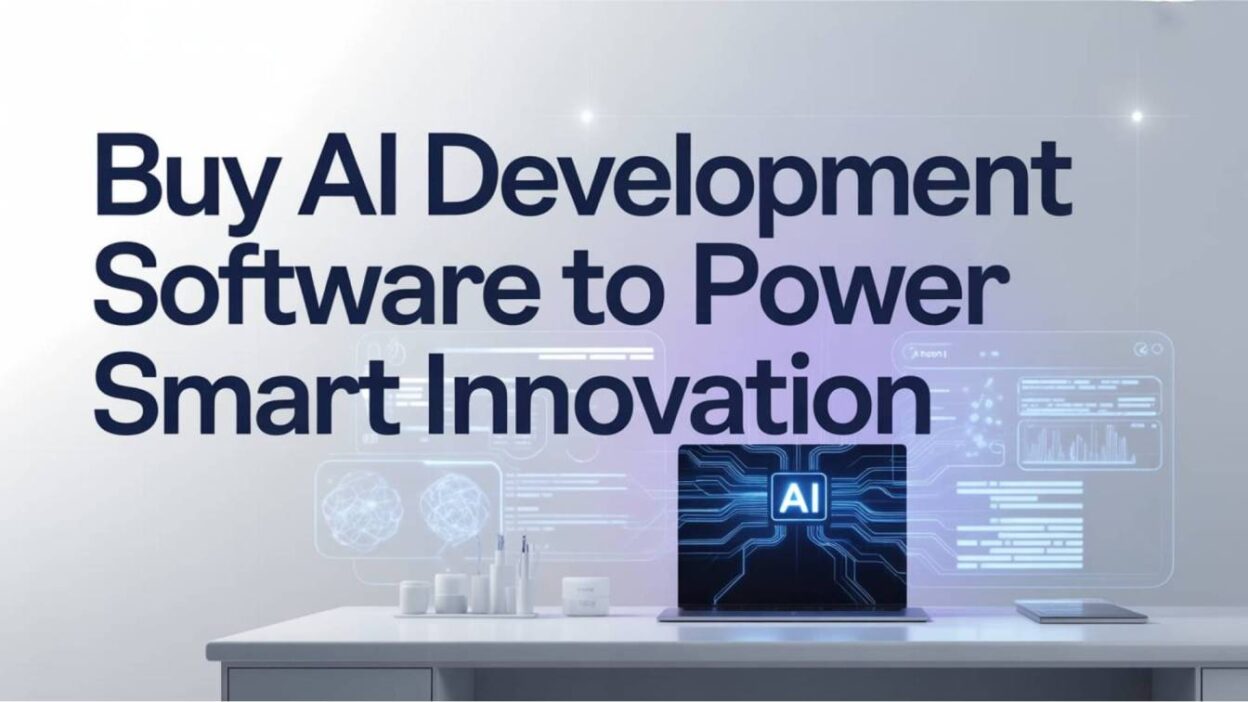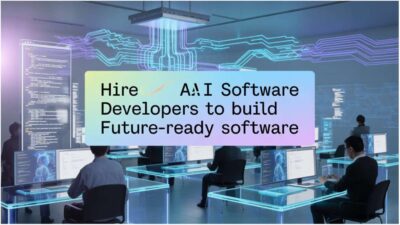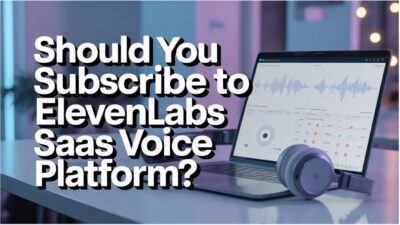Introduction
Table of Contents
TL;DR The decision to buy AI development software determines your organization’s ability to innovate and compete in rapidly evolving digital markets. Traditional software development tools lack the specialized capabilities needed to build intelligent applications that learn and adapt. Modern businesses require platforms that accelerate machine learning model creation, streamline data processing, and simplify deployment workflows.
AI development software provides integrated environments where teams design, train, and deploy intelligent systems efficiently. Generic programming tools force developers to build infrastructure from scratch for every project. When you buy AI development software designed specifically for artificial intelligence, you eliminate repetitive setup work and focus energy on solving business problems.
This comprehensive guide explores everything you need to evaluate, select, and implement AI development platforms successfully. You will discover essential features, cost considerations, vendor comparison strategies, and best practices for maximizing your technology investment.
Understanding AI Development Software
AI development software encompasses specialized platforms and tools that streamline the entire machine learning lifecycle. These solutions provide pre-built components, automated workflows, and integrated environments for creating intelligent applications. Modern platforms handle data preparation, model training, evaluation, and deployment through unified interfaces.
Core Components and Capabilities
Integrated Development Environment Comprehensive platforms offer coding interfaces optimized for machine learning with syntax highlighting and intelligent code completion. Built-in debugging tools help developers identify and resolve issues faster than generic IDEs. Specialized environments understand AI-specific workflows and provide relevant assistance throughout development processes.
Model Training Infrastructure Advanced platforms manage computational resources needed for training complex neural networks and machine learning models. Distributed training capabilities leverage multiple processors and machines to reduce training time significantly. Efficient resource management controls costs while maintaining high performance levels.
Data Management Systems Robust data handling capabilities clean, transform, and prepare datasets for model training automatically. Version control for datasets ensures reproducibility and tracks data lineage throughout project lifecycles. Proper data management prevents quality issues that undermine model performance.
Deployment and Serving Tools Production deployment features package trained models into APIs and containerized applications seamlessly. Automated scaling adjusts computational resources based on inference demand dynamically. Deployment automation reduces time from model development to business value realization.
Types of AI Development Software
End-to-End ML Platforms Comprehensive solutions like DataRobot and H2O.ai provide complete workflows from data ingestion through model deployment. End-to-end platforms suit organizations wanting unified environments rather than assembling multiple tools. Integrated approaches reduce complexity and improve team collaboration.
Framework-Specific Tools Specialized environments built around TensorFlow, PyTorch, or other specific frameworks optimize workflows for particular technologies. Framework-specific tools provide deep integration and advanced features for developers committed to specific technologies. Specialization delivers superior capabilities within chosen ecosystems.
AutoML Solutions Automated machine learning platforms democratize AI development by handling algorithm selection and hyperparameter tuning automatically. AutoML tools enable business analysts and domain experts to build models without extensive data science backgrounds. Automation accelerates development while maintaining professional quality standards.
Cloud-Native Platforms Cloud-based solutions like AWS SageMaker and Google Cloud AI Platform provide scalable infrastructure without hardware investments. Cloud platforms offer pay-as-you-go pricing models that align costs with actual usage. Native cloud integration simplifies deployment and operations significantly.
Why Organizations Need to Buy AI Development Software
Accelerating Innovation Timelines
AI development software dramatically reduces the time required to move from concept to production-ready intelligent applications. Manual infrastructure setup and configuration consume weeks or months before actual development begins. When you buy AI development software with pre-configured environments, teams start building immediately.
Rapid Prototyping Capabilities Built-in templates and pre-trained models enable quick proof-of-concept development for testing ideas. Rapid experimentation helps organizations identify viable applications before major resource commitments. Fast iteration cycles improve decision quality and reduce wasted effort.
Reduced Technical Complexity Abstracted infrastructure management eliminates low-level configuration tasks that distract from business problem-solving. Developers focus on model architecture and business logic rather than system administration. Simplified workflows improve productivity and reduce frustration significantly.
Faster Time-to-Market Streamlined deployment pipelines move successful models from development into production environments quickly. Competitive advantages depend on deploying innovations before competitors replicate capabilities. Speed advantages translate directly into market share and revenue opportunities.
Cost Efficiency and Resource Optimization
Infrastructure Investment Reduction Cloud-based AI development platforms eliminate expensive hardware purchases and ongoing maintenance costs. Organizations pay only for resources actually consumed rather than maintaining idle capacity. Capital expense conversion to operational expenses improves financial flexibility.
Developer Productivity Gains Integrated tools and automated workflows enable developers to accomplish more with fewer person-hours. Productivity improvements reduce project costs and enable smaller teams to deliver greater value. Efficiency gains compound across multiple projects and initiatives.
Reduced Trial and Error Built-in best practices and automated optimization reduce experimental cycles needed to achieve quality results. Faster learning curves minimize wasted effort on approaches unlikely to succeed. Efficient experimentation reduces overall project costs substantially.
Competitive Advantage Through Technology Leadership
Advanced Capability Access Enterprise-grade AI development software provides access to cutting-edge techniques and algorithms without building expertise internally. Pre-built capabilities enable organizations to leverage state-of-the-art methods immediately. Technology access accelerates capability building compared to developing everything from scratch.
Scalability for Growth Professional platforms handle growing data volumes and user demands without requiring platform migrations. Scalable architecture accommodates success without disruptive technology changes. Growth-ready solutions protect investments as business needs evolve.
Innovation Enablement Powerful development tools enable teams to experiment with creative applications and novel approaches. Innovation cultures require tools that support exploration without excessive risk or cost. Proper platforms foster creativity while maintaining quality standards.
Essential Features to Evaluate
Development Environment Capabilities
Notebook Integration Jupyter notebook support enables interactive development and experimentation favored by data scientists. Integrated notebooks combine code, visualizations, and documentation in unified environments. Interactive development accelerates learning and exploration phases.
Collaborative Features Multi-user environments allow teams to work together on shared projects with version control integration. Collaboration capabilities prevent duplicated effort and facilitate knowledge sharing. Team-friendly platforms improve overall organizational capabilities.
Language and Framework Support Comprehensive platforms support Python, R, and other languages commonly used in AI development. Multiple framework compatibility prevents vendor lock-in and accommodates diverse team preferences. Flexibility enables organizations to adopt best tools for specific problems.
Visualization Tools Built-in visualization capabilities help developers understand data distributions and model behavior quickly. Interactive graphics enable rapid insight generation and effective stakeholder communication. Visual tools improve decision quality throughout development processes.
Model Development and Training
Automated Hyperparameter Tuning Intelligent optimization automatically tests parameter combinations to identify optimal model configurations. Automation eliminates tedious manual tuning that consumes significant developer time. Optimized models deliver better performance with less effort.
Distributed Training Support Multi-GPU and multi-node training capabilities reduce time required for complex model development. Distributed computing enables experimentation with larger models and datasets. Training speed directly impacts innovation velocity and competitive positioning.
Experiment Tracking Comprehensive logging captures all experimental parameters, results, and artifacts automatically. Experiment management enables reproducibility and systematic improvement over time. Proper tracking prevents losing valuable insights from previous work.
Model Versioning Version control for trained models tracks changes and enables rollback to previous versions when needed. Model versioning supports A/B testing and gradual rollout strategies. Proper version management reduces deployment risk significantly.
Deployment and Operations
One-Click Deployment Simplified deployment workflows package models into production-ready services with minimal manual configuration. Easy deployment reduces technical barriers and accelerates value realization. Deployment simplicity enables frequent updates and continuous improvement.
Monitoring and Alerting Production monitoring tracks model performance, data quality, and system health continuously. Automated alerts notify teams of degradation or failures requiring attention. Proactive monitoring prevents silent failures that damage business outcomes.
A/B Testing Infrastructure Built-in testing frameworks enable systematic comparison of model versions in production environments. Statistical rigor ensures deployment decisions rely on evidence rather than assumptions. Testing capabilities improve continuous optimization effectiveness.
API Management Robust API gateways control access, manage rate limiting, and track usage patterns for deployed models. Professional API management enables monetization and partner integration opportunities. Well-managed APIs provide flexibility for various consumption patterns.
Comparing Leading AI Development Platforms
Enterprise-Grade Solutions
AWS SageMaker Amazon’s comprehensive platform integrates deeply with AWS ecosystem and provides extensive pre-built algorithms. SageMaker offers managed Jupyter notebooks, distributed training, and automated model tuning. Strong cloud integration suits organizations already invested in AWS infrastructure.
Google Cloud AI Platform Google’s solution leverages TensorFlow expertise and provides excellent integration with BigQuery and other GCP services. AutoML capabilities democratize AI development across technical skill levels. Google’s research leadership translates into cutting-edge platform features.
Microsoft Azure Machine Learning Azure ML provides enterprise security, compliance certifications, and hybrid cloud deployment options. Strong integration with Microsoft ecosystem benefits organizations using Office and other Microsoft products. Enterprise-friendly features suit regulated industries and large organizations.
IBM Watson Studio Watson Studio emphasizes collaboration, governance, and responsible AI development with built-in bias detection. Industry-specific solutions accelerate development in healthcare, finance, and other verticals. Watson’s cognitive services complement custom model development effectively.
Specialized Platforms
DataRobot Automated machine learning platform that handles entire model lifecycle with minimal coding required. DataRobot excels at enabling business users to build models independently. Strong AutoML capabilities accelerate time-to-value substantially.
H2O.ai Open-source foundation with enterprise features for scalable machine learning across various deployment options. H2O provides excellent model interpretability and explainable AI capabilities. Cost-effective licensing models suit budget-conscious organizations.
Domino Data Lab Collaboration-focused platform that emphasizes reproducibility and knowledge sharing across data science teams. Domino excels at managing complex workflows and diverse tool requirements. Strong governance features suit enterprises with compliance requirements.
Databricks Unified analytics platform combining data engineering and machine learning on scalable infrastructure. Databricks excels at handling big data workloads and streaming applications. Apache Spark integration provides powerful data processing capabilities.
Cost Considerations and Budgeting
Pricing Models and Structures
Subscription-Based Licensing Monthly or annual subscriptions provide predictable costs based on user counts or feature tiers. Subscription models suit organizations preferring operational expense structures over capital investments. Predictable pricing simplifies budget planning and financial forecasting.
Usage-Based Pricing Pay-per-use models charge based on computational resources consumed during training and inference. Usage pricing aligns costs with actual business value generation. Variable costs suit organizations with unpredictable or seasonal AI workloads.
Hybrid Pricing Approaches Combined models include base subscriptions plus additional charges for compute resources or advanced features. Hybrid structures balance predictability with usage flexibility. Mixed models accommodate diverse organizational needs effectively.
Open Source vs. Commercial Free open-source tools require investment in infrastructure and support while commercial platforms bundle everything. Total cost of ownership includes hidden expenses beyond license fees. Comprehensive analysis reveals true cost differences between options.
Total Cost of Ownership Analysis
Infrastructure Expenses Cloud resource consumption for training and inference represents ongoing operational costs. On-premise deployments require hardware investments plus maintenance and upgrades. Infrastructure costs often exceed software licensing over multi-year periods.
Personnel and Training Staff learning curves and ongoing education costs impact total investment in AI capabilities. Complex platforms require more extensive training and specialized expertise. User-friendly solutions reduce training burden and accelerate productivity.
Integration and Customization Connecting AI platforms with existing systems requires development effort and potential consulting expenses. Custom workflow development and specialized feature additions increase total costs. Integration complexity varies significantly between platforms and organizational environments.
Opportunity Cost of Delays Extended evaluation and implementation periods delay competitive advantage realization and revenue opportunities. Faster deployment through better platform selection offsets higher license costs through earlier value capture. Decision speed matters as much as cost optimization.
Selecting the Right Platform for Your Needs
Requirements Assessment
Use Case Identification Document specific AI applications your organization plans to develop across different business units. Clear use case definitions guide platform feature requirements and capability priorities. Vague requirements lead to suboptimal platform selections.
Technical Skill Inventory Assess current team capabilities including programming languages, frameworks, and cloud platform experience. Platform selection should match existing skills while supporting capability expansion. Mismatched platforms create adoption barriers and training burdens.
Scale and Performance Requirements Estimate data volumes, model complexity, and inference throughput needed for planned applications. Performance requirements determine necessary computational capabilities and scalability features. Underestimating scale leads to expensive platform migrations later.
Integration Needs Identify existing systems requiring integration including data sources, applications, and infrastructure platforms. Integration complexity impacts implementation timelines and ongoing operational costs. Poor integration assessment causes deployment failures.
Evaluation and Selection Process
Vendor Demonstration Requests Schedule detailed platform demonstrations using your actual data and use cases rather than generic examples. Real-world testing reveals practical capabilities and limitations accurately. Generic demos hide potential issues and compatibility problems.
Proof of Concept Execution Conduct hands-on trials building actual models your organization needs using evaluation platforms. POC results provide objective evidence for decision-making rather than vendor claims. Practical experience exposes workflow friction and missing features.
Reference Customer Conversations Contact existing customers with similar industries and use cases to understand real-world experiences. Candid reference discussions reveal vendor strengths and weaknesses honestly. Reference insights prevent expensive mistakes from marketing-influenced decisions.
Total Cost Modeling Build comprehensive financial models including licensing, infrastructure, training, and opportunity costs. Multi-year projections reveal true cost differences between alternatives. Accurate modeling prevents budget surprises after commitment.
Implementation Strategy and Best Practices
Planning and Preparation
Stakeholder Alignment Secure executive sponsorship and cross-functional support before beginning platform implementation. Leadership backing ensures necessary resources and organizational cooperation. Insufficient support causes initiatives to stall during challenges.
Pilot Project Selection Choose initial projects that demonstrate value quickly while manageable scope limits implementation risk. Successful pilots build momentum and organizational confidence for broader rollouts. Overly ambitious first projects increase failure probability.
Team Formation and Training Assemble cross-functional teams including data scientists, engineers, and business analysts for balanced capabilities. Invest in comprehensive training that covers both technical and business aspects. Well-prepared teams execute implementations more successfully.
Success Metrics Definition Establish clear, measurable objectives for both technical performance and business impact. Quantifiable metrics enable objective success assessment and ongoing optimization. Vague goals allow drift and reduce accountability.
Deployment and Rollout
Phased Implementation Approach Roll out platforms gradually across teams and use cases rather than organization-wide launches. Phased approaches enable learning and adjustment based on early experiences. Gradual expansion reduces risk and improves ultimate success rates.
Documentation and Standards Create comprehensive documentation covering workflows, best practices, and organizational conventions. Clear standards improve consistency and enable knowledge transfer across teams. Poor documentation hampers scaling and creates dependencies on individuals.
Governance Framework Establishment Implement policies for model approval, deployment authorization, and ongoing monitoring responsibilities. Governance prevents unauthorized deployments and maintains quality standards. Proper oversight balances innovation speed with risk management.
Continuous Optimization Culture Foster organizational commitment to ongoing improvement based on usage data and feedback. Optimization mindsets prevent complacency and maintain competitive advantages. Static implementations lose effectiveness as needs evolve.
Maximizing Value from Your Investment
Adoption and Change Management
Champion Development Identify and empower enthusiastic early adopters who evangelize platforms and help colleagues. Champions accelerate adoption through peer influence and grassroots support. Organic advocacy proves more effective than top-down mandates.
Quick Wins Demonstration Prioritize projects delivering visible results rapidly to build organizational enthusiasm. Early successes create positive momentum and justify continued investment. Delayed value realization allows skepticism to undermine initiatives.
Feedback Collection and Response Regularly gather user feedback about platform capabilities, pain points, and improvement suggestions. Responsive adjustments demonstrate commitment to user success and improve satisfaction. Ignored feedback breeds frustration and resistance.
Success Story Communication Share achievements and lessons learned across organizations to inspire and educate broader teams. Effective communication multiplies impact beyond direct participants. Publicity builds reputations and attracts resources for expansion.
Advanced Capabilities Exploration
Feature Set Expansion Gradually adopt advanced platform capabilities as teams master foundational features. Incremental skill building prevents overwhelming users while maximizing platform value. Progressive expansion maintains engagement and drives continuous improvement.
Custom Extension Development Build specialized components and integrations that address unique organizational requirements. Custom development maximizes platform fit to specific needs and workflows. Extensions create competitive differentiation through tailored capabilities.
Community Engagement Participate in user communities, forums, and events to learn best practices and share experiences. Community connections provide valuable support beyond vendor relationships. Network effects accelerate learning and capability development.
Common Challenges and Solutions
Technical Integration Issues
Legacy System Compatibility Older systems may lack modern APIs and data formats required for seamless integration. Integration middleware bridges gaps between legacy infrastructure and modern AI platforms. Gradual modernization strategies balance innovation with stability.
Data Access Barriers Organizational data silos and security restrictions complicate data pipeline development. Cross-functional collaboration and executive support overcome bureaucratic obstacles. Data democratization initiatives enable AI platform effectiveness.
Performance Optimization Initial implementations may experience latency or throughput issues requiring tuning and adjustment. Performance engineering combines platform configuration with code optimization. Iterative improvement addresses bottlenecks systematically.
Organizational Adoption Challenges
Skill Gap Management Existing staff may lack expertise needed to leverage sophisticated AI development platforms fully. Structured training programs combined with external hiring fill capability gaps. Skill development requires sustained investment and patience.
Resistance to Change Established workflows and familiar tools create inertia against platform adoption. Change management strategies address concerns and demonstrate concrete benefits. Leadership support and incentives overcome resistance effectively.
Resource Competition Platform implementation competes with other initiatives for limited organizational resources. Clear value demonstration and executive sponsorship secure necessary priority. Competing initiatives require careful portfolio management.
Future-Proofing Your AI Infrastructure
Emerging Technology Trends
Edge AI Deployment Increasing demand for on-device intelligence requires platforms supporting edge deployment workflows. Edge capabilities reduce latency and enhance privacy for mobile and IoT applications. Forward-looking platforms include edge deployment features.
Automated Machine Learning Evolution AutoML capabilities continue advancing to handle increasingly complex scenarios with less human intervention. Democratization trends expand AI development access across organizations. Automation investments pay dividends through reduced expertise requirements.
Responsible AI Features Bias detection, fairness metrics, and explainability tools become standard platform requirements. Regulatory pressures and ethical considerations drive responsible AI capabilities. Compliance-ready platforms reduce legal and reputational risks.
Quantum Computing Integration Emerging quantum capabilities enable entirely new classes of machine learning algorithms. Early quantum integration positions organizations for breakthrough advantages. Forward-thinking platforms prepare for quantum transitions.
Platform Evolution and Vendor Relationships
Vendor Roadmap Assessment Evaluate vendor investment in research and development for continued platform innovation. Stagnant platforms lose competitive positioning as alternatives advance. Active development ensures long-term value from investments.
Migration Path Planning Understand options for transitioning between platforms if business needs or vendor situations change. Migration-friendly architectures reduce switching costs and prevent vendor lock-in. Flexibility protects long-term strategic options.
Multi-Platform Strategies Consider using multiple specialized platforms for different use cases rather than forcing single-solution approaches. Best-of-breed strategies optimize capabilities for specific needs. Multi-platform management requires additional coordination overhead.
Measuring Success and ROI
Performance Metrics
Development Velocity Track time required to move from concept through production deployment for AI projects. Accelerated timelines demonstrate platform effectiveness and team maturity. Velocity improvements indicate successful adoption and capability building.
Model Quality Improvements Measure prediction accuracy, precision, recall, and other relevant metrics for deployed models. Quality improvements validate platform capabilities and development practices. Stagnant quality suggests optimization opportunities.
Resource Utilization Efficiency Monitor computational resource consumption and costs relative to business value generated. Efficient resource usage maximizes ROI and enables broader AI adoption. Optimization efforts improve long-term sustainability.
Business Impact Assessment
Revenue Generation Calculate direct revenue attributable to AI applications built using development platforms. Revenue impact proves business value beyond technical achievements. Financial results justify continued investment and expansion.
Cost Reduction Measurement Quantify operational expense decreases from automation and improved efficiency enabled by AI. Cost savings provide tangible ROI that complements revenue opportunities. Multiple value streams strengthen business cases.
Strategic Advantage Realization Assess competitive positioning improvements from AI capabilities and innovation leadership. Strategic benefits often exceed immediate financial returns. Long-term advantages justify platform investments.
Read More: From Weeks to Days: Faster Delivery with AI Tech
Conclusion

The strategic choice to buy AI development software fundamentally shapes your organization’s innovation capacity and competitive positioning. Proper platforms accelerate development cycles, improve model quality, and democratize AI capabilities across teams. Investment in the right development environment delivers compounding returns through sustained innovation.
Successful platform selection requires a comprehensive evaluation of features, costs, and organizational fit factors. Rushed decisions lead to expensive mistakes, while excessive deliberation delays competitive advantage realization. Balanced approaches identify optimal solutions that serve both immediate needs and long-term strategies.
Implementation success depends equally on technology selection and organizational change management execution. Powerful platforms deliver value only when teams adopt them enthusiastically and use them effectively. Sustained focus on adoption and optimization maximizes returns on platform investments.
When you buy AI development software strategically, you build organizational capabilities that adapt and evolve with technology advancements. Future-ready platforms enable continuous innovation that maintains competitive advantages in rapidly changing markets. Smart investment in development infrastructure positions your organization for sustained success in the AI-driven future.





